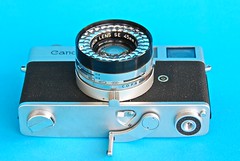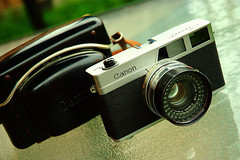Canon Canonet
| Canon Canonet |
|---|
|
Manufacturer: Canon
Film type: 35mm
|

|
| The original Canonet image by -RobW- (Image rights) |
The Canon Canonet was released in 1961 and is remembered as Canon's first entry into the intermediate-class camera market, and also the first of the highly successful Canonet series of 35mm automatic-exposure rangefinder cameras.
The top plate only houses the shutter-release, with a locking ring for time-exposures, the frame counter and an accessory shoe.
The clean lines of the top are achieved by putting the advance lever underneath, together with the rewind crank, rewind release and back catch. The advance lever had an end which hinged downwards, making it easy to operate using the left middle- or third-finger. These controls on the bottom necessitate corresponding holes in the every-ready case.

|
| ...with wind & rewind levers on bottom image by Dirk HR Spennemann (Image rights) |

|
| The Canonet's clean top panel... image by Dirk HR Spennemann (Image rights) |
Rangefinder focusing is controlled by a lever attached to the focus ring, also at the bottom of the camera.
The selenium meter cell is arranged around the Canon SE 45mm f1.9 lens - thus automatically compensating for filters; the aperture ring is scaled from f16 down to f1.9, followed by an "auto" setting (with a latch), for shutter priority automation. The Copal SV shutter has speeds from 1/500 down to 1sec, plus B. Film speed is set between 10-400 ASA by a lever in the shutter speed ring. The viewfinder features a bright-line frame, and a scale showing the aperture.
There is a PC socket beside the lens, and a switch on the lens barrel for X- or M-flash sync.
There is a self-timer - set by a lever on the lens barrel.
The Canonet was also sold by Bell & Howell as the Bell & Howell / Canon Canonet 19.
There were three versions of this camera. Version 1 had viewfinder arrows to indicate under and over exposure (there was no aperture scale in viewfinder), an ASA range of 10 – 200, and no Cloudy/Sunny settings on the lens barrel. Version 2 introduced the aperture scale in the viewfinder, retained an ASA range of 10 – 200, and added the Cloudy/Sunny settings on the bottom of the lens. Version 3 was the same as version 2, but had an increased film speed range of 10 – 400 ASA.
Canon, at the time known as a high-end camera maker, caused commotion in the industry at the idea of this mid-priced camera. However, initial stocks sold out in only two hours after release. Within two and a half years, a million Canonets had been sold[1], and successive Canonet models continued into the mid 1970s. The Canonet name was also used for some 8mm cine cameras, as Cine Canonet.
Notes
Links
- Canonet via Internet Archive: The Wayback Machine
- Canonet manual at Mike Butkus Orphan Cameras
- Canonet at the Canon Camera Museum
- Bell & Howell Canonet 19 at Sylvain Halgand's Collection Appareils (in French)
